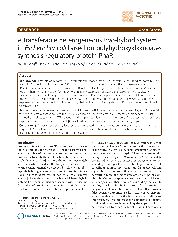摘要
Background: Polyhydroxyalkanoate (PHA) synthesis regulatory protein PhaR contains a DNA binding domain (DBD) and a PHA granule binding domain (GBD), it anchors to the promoter region of PHA granule-associated protein (PhaP) to repress phaP expression. However, PhaR will bind to PHB granules and be released from phaP promoter region when PHA granules are formed in vivo, initiating expression of phaP gene. Based on this regulatory mechanism, a bacterial two-hybrid system was developed: PhaR was separated into two parts: DBD was used to fuse with the bait, GBD with the prey, and phaP was replaced by a reporter gene lacZ. However, GBD protein expressed in vivo formed inclusion bodies. Thus, PhaP with strong binding ability to PHB granules was employed to replace GBD.
Results: Three model interaction partners bFos, bJun and bATF2 were used to study the feasibility of this bacterial two-hybrid system compared with the controls lacking one or more essential elements of this system. Results showed that bFos, bJun and bATF2 bound tightly in pairs to allow strong expression of beta-galactosidase in different expression levels. In contrast, very weak beta-galactosidase activity was detected in all control groups.
Conclusion: beta-Galactosidase activity level precisely correlated with the interaction force of tested protein pairs, and very weak beta-galactosidase expression was detected throughout the control groups, which demonstrated the feasibility of this system for studying protein interactions.
